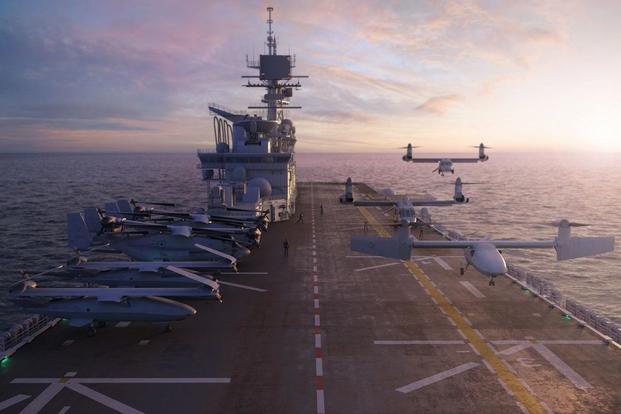The Marine Corps is a step closer to getting a large unmanned aircraft that can launch from ships, fly a radius of up to 700 nautical miles with a full payload, escort the MV-22 Osprey and other platforms, network with other manned platforms, and provide offensive air support, including targeting and strike.
This incredible unmanned aerial system is known as MUX, for Marine Air Ground Task Force Unmanned Aircraft System-Expeditionary.
Marine officials began publicly discussing plan to design and build MUX in 2016. A request for information for the aircraft, directed to companies interested in designing and building it, was released March 9.
In late 2016, Lt. Gen. Jon Davis, then head of Marine Corps aviation, described MUX as a Group 5 aircraft that could carry all the weapons on an F-35B, fly at 30,000 feet, and provide key electronic warfare and command-and-control capabilities.
"If we do distributed operations, we're going to need all the game we can bring," Davis said at the time.
According to the 35-page request for information, the Corps wants an aircraft capable of carrying internal and external payloads totaling 9,500 pounds.
Weapons the service wants MUX to carry for various missions include AGM-114 Hellfire air-to-surface missiles; AIM-9X air-to-air missiles; the advanced precision kill weapon system (APKWS) laser-guided rocket; the AIM-120 Advanced Medium-Range Air-to-Air Missile, or AMRAAM; the AGM-88E Advanced Anti-Radiation Guided Missile (AARGM); small-diameter bombs; and an expendable unmanned aerial vehicle for early warning and electronic warfare.
Top-priority missions for the MUX include early warning; intelligence, surveillance and reconnaissance; electronic warfare; and communications relay. Secondary missions include offensive air support, aerial escort and cargo transportation, according to the document.
The Corps also wants an aircraft that can take off vertically, fit on a ship with a similar footprint to a UH-1Y Venom, receive aerial refueling, and put down in austere landing zone, the RFI states.
The document provides a better timeline for when the Marine Corps wants to see the aircraft become a reality. The service wants early operational capability by 2025 for a land-based takeoff configuration, with initial operational capability for sea-based vertical takeoff and landing by 2028. Full operational capability is requested by 2034.
Among companies that have expressed interest in filling the MUX requirement are Bell, with the V-247 Vigilant tiltrotor aircraft; Piasecki Aircraft, with its affordable reconfigurable embedded system, or ARES; and Boeing, with a tail-sitting design.
During a June interview with Military.com shortly before his retirement, Davis pushed back on the suggestion that the Corps wanted too much out of the MUX program. He pointed to other now-operational aircraft platforms, saying they also seemed out of reach before they became reality.
"V-22, impossible? Nope. F-35B, impossible? Nope. Very possible, very doable, very good," he said. "Bottom line, the engineering -- this is not a pie in the sky. This is very doable."
Editor's Note: An earlier version of this story misstated which Bell design was being put forward as a MUX contender. It is the V-247 Vigilant.
-- Hope Hodge Seck can be reached at hope.seck@military.com. Follow her on Twitter at @HopeSeck.










